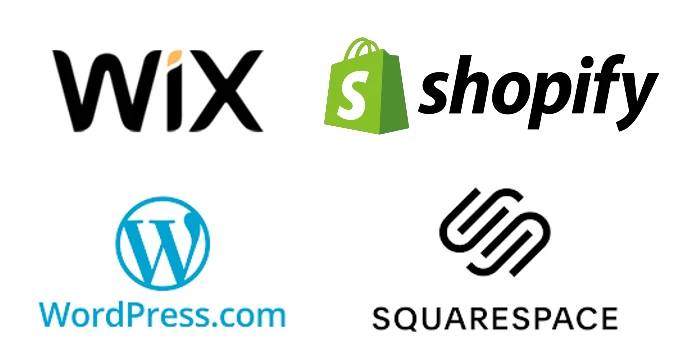Wix vs. Shopify vs. Squarespace vs. WordPress
Which Website Building Platform is Best for You?
So, you’re ready to build a website and are looking for the best platform to make it happen. With so many options available, it can be tough to choose the right one for your specific needs.

In this article, we’ll compare the four most popular website builders – Wix, Shopify, Squarespace, and WordPress – based on major features, monthly pricing, ecommerce capabilities, and pros and cons.
Let’s get after it!
Comparison of Major Features: Wix, Shopify, Squarespace, and WordPress
All four website builders offer:
-
drag-and-drop interfaces
-
customizable templates
-
tools to help you create a professional-looking website
-
statistics to help you measure progress and activity
-
monthly payment plans
However, there are differences in the features each platform provides.
Wix:
Wix is known for its beginner-friendly interface and wide variety of templates. You can easily add features like forms, social media buttons, and appointment booking to your site.
Shopify:
Shopify is the go-to choice for ecommerce websites. It offers robust inventory management, payment processing, and shipping tools.
Squarespace:
Squarespace is a great option for visual-based websites, such as photographers and artists. It has a strong focus on design and offers built-in SEO tools.
WordPress:
WordPress is the most flexible platform of the four and is ideal for bloggers and content creators. With thousands of plugins available, you can customize your site in almost any way you can imagine.
Monthly Pricing:
Wix, Shopify, Squarespace, and WordPress
Pricing is a monthly fee that you’ll have to consider an ongoing cost to running a business. It’s an important consideration when choosing a website builder. Here’s a breakdown of the monthly pricing for each platform:
Wix: Free plan, or $16 for better features
Wix offers a free plan with limited features. Paid plans start at $16 per month, with additional features available in higher tiers.
Shopify: Basic plan $29 per month
Shopify’s basic plan costs $29 per month, with more advanced plans available for larger businesses.
Squarespace: Personal plan $16 per month, Business plan $23 per month
Squarespace offers a personal plan for $12 per month and a business plan for $18 per month.
WordPress: Free platform, but you’ll need a web hosting plan $3-$45/month
WordPress is a free platform, but you’ll need to purchase web hosting and a domain name to get started. Hosting can cost anywhere from $2 to $50 per month, depending on your needs.
Ecommerce Capabilities
If you’re looking to sell products on your website, you’ll want a platform that has strong ecommerce capabilities. Here’s how each platform stacks up:
Wix offers ecommerce features, but they are not as advanced as Shopify’s.
You can set up a store and accept payments, but inventory management is limited.
Shopify is the clear winner when it comes to ecommerce.
It has powerful tools for managing inventory, fulfilling orders, and accepting payments.
Squarespace’s ecommerce tools are not as advanced as Shopify’s, but they are still suitable for small businesses.
You can accept payments, manage orders, and create discounts.
With the WooCommerce plugin, WordPress can handle ecommerce functionality.
However, it requires more technical knowledge and set-up time compared to the other platforms.
Pros and Cons
Each platform has its own set of strengths and weaknesses. Here’s a summary of the pros and cons for each platform:
Wix: Pros: Easy to use, wide variety of templates, good for beginners. Cons: Limited ecommerce capabilities, customization options are limited.
Shopify: Pros: Strong ecommerce features, excellent inventory management, reliable hosting.
Cons: More expensive than other platforms, not as flexible for non-ecommerce websites.
Squarespace: Pros: Excellent design options, built-in SEO tools, good for visual-based businesses.
Cons: Limited customization options, not as advanced ecommerce features as
other platforms.
WordPress: Pros: Highly customizable, vast plugin library, great for blogging and content creation.
Cons: Requires technical knowledge, can be difficult to set up, hosting costs can add up.
Which Platform is Right for You?
Ultimately, the platform you choose will depend on your specific needs. Here are some guidelines to help you make a decision:
If you’re a beginner and need a simple website: Wix is the easiest platform to use and offers a wide variety of templates to choose from.
If you’re running an ecommerce business: Shopify is the clear winner when it comes to ecommerce features. It offers powerful tools for inventory management, order fulfillment, and payment processing.
If you’re a visual-based business: Squarespace is a great option for photographers and artists who want a visually stunning website.
If you’re a blogger or content creator: WordPress is the most flexible platform and offers a wide range of customization options. It’s also great for SEO and content creation.
Other considerations – ongoing maintenance and support
Depending on how complicated your business or store needs are, you may need help building or maintaining your online business presence. A website can be a complicated frustrating thing if you don’t have experience in that area, so keep in mind you may need to hire help.
Read what others are saying about each platform
You can and should learn as much as you from online reviews and especially YouTube videos. That’s a great place to start to research the various major platforms.
Choosing a website builder for your new business is an important decision, but with so many options available, it can be little overwhelming.
Hopefully, this comparison of Wix, Shopify, Squarespace, and WordPress has helped you determine which platform is best for your needs. Remember, no matter which platform you choose, building a website takes time and effort. But with the right platform and a little bit of creativity, you can create a beautiful and functional website that helps your business thrive.